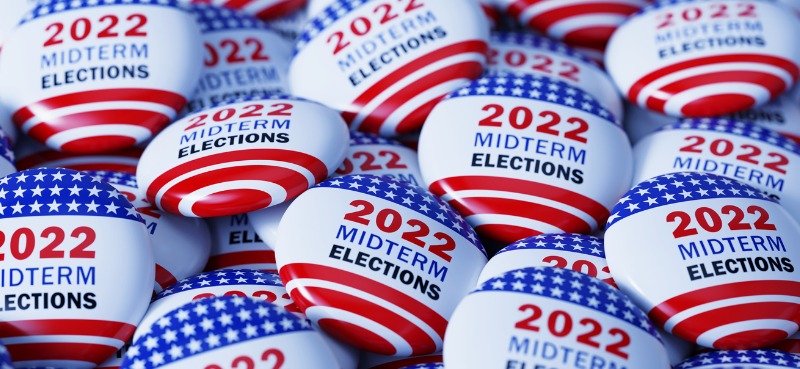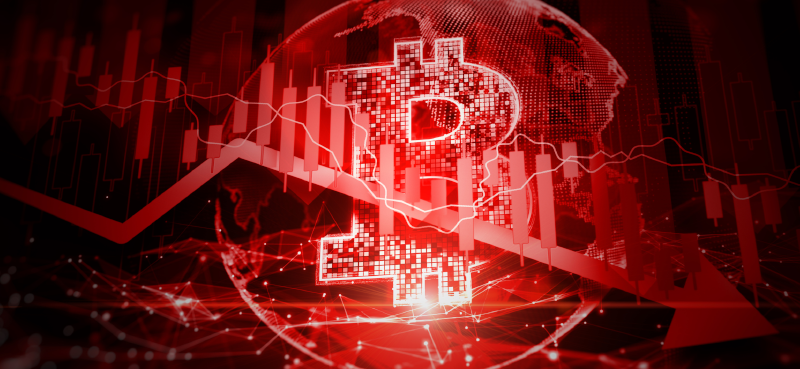Happy Election Day! I hope you all get out and vote today, since, according to the mainstream media, our democracy is at risk…
I highlight how wild politics in this country have become… why I’m being labeled a “racist” and a “radical”… and what I wish we’d focus on instead of all the fear-mongering and hate.
A split government is typically bullish for the markets… And a “red wave” would be good for business… But regardless of how the election turns out, it won’t save your portfolio—the only thing that matters is the Fed. I explain why there’s zero chance of a soft landing… Goldman Sachs’ alarming forecast… and why we’re facing a recession in 2023.
Luckily, Genia Turanova’s simple but effective Moneyflow Trader strategy was designed for exactly this kind of dangerous market. In fact, she just closed out her 17th and 18th winners year to date. And for a limited time, you can join at a deep discount.
- Have you voted yet? [0:28]
- A pro-business “red wave” won’t be enough to save the markets [4:07]
- Goldman Sachs’ warning about next year’s earnings [6:35]
- The perfect strategy for a 2023 recession [11:30]
- How to join Moneyflow Trader at a deep discount [23:15]
Wall Street Unplugged | 968
A ‘red wave’ won’t save your portfolio
Announcer: Wall Street Unplugged looks beyond the regular headlines heard on mainstream financial media to bring you unscripted interviews and breaking commentary direct from Wall Street right to you on main street.
Frank Curzio: How’s it going out there? It’s November 8th. I’m Frank Curzio, host of the Wall Street Unplugged podcast, where I break down the headlines and tell you what’s really moving these markets. Happy election day. I hope all of you, Democrats and Republicans, go out and vote. And you need to because the future of American democracy is at stake. I think I’ve heard that like a million times in past week. As you know, I am a Republican. I think sometimes when you’re Republican, people are afraid to admit that because everyone thinks you’re some crazy right wing conservative, which you know I’m not. But being a Republican these days makes me a racist, a white supremacist, which I’m not sure what that means, by the way. I know what it means, I just haven’t seen it in my lifetime, but that’s what I am now.
Frank Curzio: MSNBC says Republicans are not very bright. Also called out Hispanics and Blacks who are voting Republican, that they are the product of misinformation, meaning that they’re not smart enough to do their own research and vote accordingly, or how The View called white suburban Republican women cockroaches. This is what we are. But I didn’t know I was such an asshole because I was part of a party that is the Republicans, where the things I represent, I just want my kids to be… Or not be conditioned by teachers to have an agenda. I want to be able to take my kids to New York City again, which I can’t do because it’s not safe. I want criminals to stay locked up when they commit a crime. I want more police on the streets to protect everyone, while really punishing the 2% who abuse their badge. I want pretty much I think what everyone wants, your kids or my kids have a better life than me, in a capitalistic society that rewards hard workers.
Frank Curzio: But I guess according to CNN, MSNBC, and left wingers, that makes me an illiterate idiot, or white supremacist. Kind of insulting, just because I have certain views. I’m sure that’s not the same views that everyone has when they listen to this podcast. But we could agree on a lot of things that we want to see with our country. And talking politics makes you want to cringe sometimes. I get some emails coming in, whatever. I always like debates and talking politics is always a heated discussion now, it’s like you got to hate the other side, no matter what. I get it, especially if you’re watching TV, or the media, the networks, holy shit. I mean, there’s no happiness; you can’t get along.
Frank Curzio: Many of us support a lot of the things that we want, especially when it comes to our children, education and safety. But instead of getting heated all the time, especially today, is going to get nuts, or politicians that really… Look, I mean, they don’t give a shit about you and me. I mean, they spent a record 16 billion on these midterm elections, which… That kind of money doesn’t come from you, me, middle class voters. It comes from major corporations and billionaires who are what? Trying to maintain power and get more wealthy. They want to piss off people as much as they can. Over the next few years, you should be focusing on you, your family, your wealth. In terms of adjusting your portfolio based on the new policies that will be enacted or changed, or even left alone, since we’re going to have a split government, most likely with the Republicans set to win the house. Many predict they’re going to take the Senate. We’ll see, by the time you listen to this you might know, who knows?
Frank Curzio: But that’s what smart investors do. They don’t take off work and hold up signs in protest, they figure out ways to capitalize, how to benefit from these policies regardless of their personal beliefs because that’s how you create generational wealth. At the end of the day, it’s about you and your family.
Frank Curzio: And one of the biggest issues right now, which we all know, is inflation. And we had the Fed tell us last week, straight up, right to our faces, just like Powell has been saying the whole time, that they’re going to be raising rates, they’re not pausing. It’s going to continue well into 2023, at least for the first quarter because it’s the only way to control inflation, meaning there is zero chance of us having a soft landing, since the Fed can’t make inflation fall near its 2% target unless they destroy demand. And how do they do that? Raising rates and tricking its balance sheet.
Frank Curzio: So, it’s interesting because after the Fed meeting last week, Goldman Sachs, the ultimate rich research firm, released a note to its clients saying it now expects earnings to be flat in 2023, next year, flat, something they’ve been talking about for a while now, at least the past two months. It’s a big change from the 10% growth Goldman Sachs predicted earnings would grow this quarter in Q3, and where they up? Like 2% thus far? There are more companies yet to report. But more than 70%, 75% have reported already, maybe a little more than that. But they’re down big, excluding energy, whose profits are up over 100% year-over-year. But for Goldman Sachs, it’s an even bigger change from the 7% growth in earnings it was expecting for next year, 2023, which it highlighted through October, that it’s insane to believe that the earnings are going to grow this year and also next year. They have to come down sharply.
Frank Curzio: Now, this is a major story that few are talking about and that’s my opinion. I don’t see it a lot, and I follow this stuff in the media, where I say earnings for S&P 500 need to be adjusted by at least 25% to 30%. And when I’m listening to conference calls, I’m seeing earnings, I’m seeing these estimates, the one that you see on TV, where they lowered sharply so they could beat them. 70% of companies beat earnings estimates if they had the same estimates for three months ago, 80% would’ve missed. Nobody pays attention to that.
Frank Curzio: But I saw this Goldman story mentioned through numerous media outlets, read about three or four of them and how they expect zero growth in earnings next year. Very big story. But also in that report, which I have access to, it was not mentioned in the media reporting, Goldman said that if we have a recession next year, which by the way, I think almost every economist is now predicting. I mean, I think it was 2007, it was something like 25% of the economists predicted a recession and we had one. So, anything over 25%, 30% is like 100%. I think the estimates right now are calling for 35%, 40% now. So, it’s almost guaranteed everyone believes we’re going to have recession. But Goldman said in that same report, which was not mentioned any place, and I have access to it, that earnings could fall 11% to $200 if we have a recession. That’s pretty crazy and that’s just the $200.
Frank Curzio: Now, what does that $200 mean? I’ve been explaining to you and trying to make it easy as possible that that’s the number of all the S&P 500 earnings combined. So, when they say that S&P 500’s trading at 70 times forward earnings, it’s price divided by earnings. You take the price S&P 500, this is the number in earnings that they’ve divided by to get to the 17 times, 18 times, 16 times they compare it. So, now Goldman is saying it could fall 11%, $200 if we have a recession. That’s not 0% growth, that’s a massive decline of 11%.
Frank Curzio: Now, to put this in perspective, at $200, which is sharply lower than what they’re predicting today at 237, which is the consensus estimate of all these analysts, which is consensus, they put it together, much, much lower, but it’s still 25% higher than the peak earnings we saw at the end of 2019, so pre-COVID or before the government decided to inject $11 trillion plus into our markets, initiate a massive bond buying program, which is called quantitative easing, and lowered rates to zero. Now, next year, what’s going to happen? The Fed’s going to be aggressively shrinking its balance sheet that’s QT known as quantitative tightening. Tightening, where they’re going to be removing as much of this $11 trillion in liquidity as possible from the economy while hiking rates, where short-term rates will average easily more than 4%, probably closer to 5% for the entire year.
Frank Curzio: Again, they were below 2%, these rates in 2019, when we hit peak earnings of 160 and the Fed was aggressively buying bonds back then. Different environment, and for Goldman Sachs, its worst case scenario if we have a recession is for S&P 500 earnings to fall to just $200, which is still extremely aggressive.
Frank Curzio: But again, it’s a story I’m not seeing mentioned a lot, the massive collapse in earnings per share, the S&P 500 next year, which is not factored into the equity markets right now. That’s why you’re seeing so many stocks report reporting getting destroyed. Some of them are beating estimates and not seeing that huge gain unless they were down further. But it’s not being priced in. I know, I’m listening to the conference calls, I’m listening to the companies, some of them it’s priced in, not everything, but some of them it’s priced in.
Frank Curzio: You may think just because the stock has fallen 70% that it’s priced in, but it’s not. Especially since some of these stocks are still trading at 70 to a hundred times forward earnings, but it’s not being factored into equity markets right now. Because you look three months ago, analysts like Goldman Sachs were predicting earnings were shared to rise 17% over the next 18 months, so through 2023. I mentioned earlier, 10% Q3, 7% next year, and just what? A few months later, they’re now predicting basically no growth. I mean, that’s a massive change in just a few months and why are they changing? Because they’re seeing the fast deterioration of fundamentals across most industries, including housing. Holy shit. Talk to your local real estate agent. Talk to anyone in this industry. It’s insane right now. It’s like it was a faucet that was just completely shut off, not slow. That’s what happens when you raise rates so fast. Completely just shut off, goodbye. If you have cash, you could buy a house. If not, good luck.
Frank Curzio: Look at what happened to technology companies, look at what happened to semiconductors. Look what’s happened to autos, prices coming down tremendously, demand shrinking up. Seeing current loans becoming delinquent, into levels you haven’t seen in many, many, many years. Look at consumer discretionary, look at retail with the inventory levels, and it’s going to hit industrials and defense sectors soon enough.
Frank Curzio: So, how do you play this market where we’ve already seen tons of stocks fall by 20% plus this year, only to rally 16% from July into August, and then collapsed through September, and then rise 14% in October, which is the best month for major industries over 40 years? Holy cow. It’s not easy, but I want to take you through a situation.
Frank Curzio: I need you to pay attention to this because there’s a company called Atlassian, the symbol is T-E-A-M, TEAM. Maybe not have heard of this company, it’s a massive software cloud company where its platform helps businesses, especially ones with huge development teams, which is massive now, helps them work more efficiently, and the technology’s awesome. Now, this was a $450 stock a year ago, before most cloud software names got nailed, and in June, the stock was trading around $180. Came down sharply along with the rest of the market, again this area got nailed. So, it’s down a lot from its highs, but still selling at extreme valuation. This is where Genia Turanova, editor of our Moneyflow Trader newsletter, where its main strategy is to buy long dated puts, told the subscribers to take a position.
Frank Curzio: Hear me out, because if you’re looking for your portfolios to be safe, if you’re looking to make a killing when stocks go lower, listen to the situation. I’m not cherry picking here; I’m using this. This is the latest example. So, a recommendation was to buy December 16th, 2022, $140 put, which is basically betting that the stock will fall below $145 a share over the next six months. The stock was trading around 180 at the time. Buying puts is not shorting a stock, where your risk is unlimited, or you’re going to lose a fortune if the stock takes off just maybe in the couple weeks, or a couple months, or you bought just before October. It’s a put where the most can lose, the money you spend on the put. Whether it’s 500,000, whether it’s 5,000 or whether it’s 500 bucks, depending on how big your portfolio is.
Frank Curzio: Now, what happened to the stock? Well, as soon as Genia took this position, we saw a massive rally which was bad, in July to August. And Atlassian participated, surging from 180; remember, she has to bet for this thing to fall below 145. It went from 180 to 275, less than two months. So, the put was worthless at first, still owned it. But the stock then fell at 230, sold off a little bit in September before going back over 250 a share, when we had the massive rally in October.
Frank Curzio: But then at the end of October, a week ago, the company reported earnings and it was a disaster, which we’re going to continue to see because estimates are way, way too high for most companies. The guidance was also a disaster, which showed that sales earnings are going to grow much slower than expected. This is the worst thing, this is the death of any super expensive growth stock. The worst thing is to report and say not only did you miss estimates, you can say, “Oh, we missed estimates and contracts were late or whatever, but we’re going to make that up.” No, they missed estimates and they also warned, the only reason why you have massive premiums on these stocks is because you’re growing much faster than the overall market. Once that growth stock stops, look out. Your stock gets destroyed. We see time and time again, in a market where a Fed is trying to destroy growth in order control inflation, it’s going to continue to happen.
Frank Curzio: So, the stock crashed close to 30% and continued moving lower, falling below the 145 price. So, the put was in the money. Genia sold half the position for around an 80% gain on Friday. The stock continued to fall on a Monday, she sold the second half position, which was yesterday, for around 100% gain, with the stock now trading at 120. Funny enough, at 120, today’s price, Atlassian is still trading over a hundred times next year’s earnings, even though the stock lost 70% of its value already. We’re seeing that among many, many technology stocks, especially software, especially fintech names that had these insane valuations.
Frank Curzio: You may be thinking, “Well, they’re down already, they’re probably not going to go lower.” Now, imagine if you shorted that stock at 180 instead of buying the put. One month later, it was at 280. So now, you’re sleeping on a park bench trying to get your wife to unpack her bags because she’s leaving you because you just lost your life savings and your whole portfolio. Instead, you could buy the put which is a six months, much safer strategy, where losses are limited to the amount of money you put into the stock. And in a market that saw in that timeframe, this a six-month point, we saw a 16-month rally in like a month and a half, two-month period. And then another 14% rally in October, Genia was still able to book massive profits on this position, which is pretty incredible.
Frank Curzio: Now, let’s take this further back. Over the next year, what do you think we’re going to see? I think we’re going to see probably the most volatile market in my 30-year career. Maybe outside of crazy events like COVID and the credit crisis, but it could be even more volatile than that because the Fed is raising rates by its fastest pace in the history of the modern Fed era. They’re in uncharted territories, they’ve never done this, and the team that’s doing this told us a year ago that it was going to be transitory, which is insane. And they aggressively raising rates and plan to when the market is crashing, which is unprecedented. Usually, the Fed lowers rates when the market crashes. But as you know, we’re in a different environment, one that we haven’t seen in over 40 years, where inflation is completely out of control.
Frank Curzio: In order to control inflation, the Fed has to destroy demand, which means the Fed can’t stop raising rates, which is exactly what Powell told us. Everybody thought, “Oh, they’d slow up.” And he said, “For anyone thinking that we’re going to pause anytime soon, forget about it.” His very first line was, “Our main goal, 100%, is to get inflation back to 2%.”
Frank Curzio: Goldman Sachs just release a report yesterday and said at the end of 2024, not next year, the end of 2024, that’s when they expect rates or the CPI, inflation, to go to 2.7%. That’s how difficult it’s going to be. So, what does this mean? You’re going to continue to see these markets where stocks fall sharply, then bounce back, because they’re going to be a little optimism and we’re done, but are likely to continue to hit new lows. When I look at it, it’s inevitable. I mean, all I can see is small pop post-election, since split governments are usually favorable for the markets, maybe we see some inflationary indicators moderate in January or February. Many are going to believe the Fed’s going to stop hiking or even maybe lower, which we saw in October was definitely not the case, and the Fed never said that was going to be the case. Just something that we thought.
Frank Curzio: But as long as the Fed is tightening, and keeping rates at that level, and maintaining quantitative tightening policies, when you’re seeing these gains or these quick moves ups, to the upside, they’re going to be used to take profits. Just like the opposite happened. When the Fed kept rates near zero for 12 years and was buying bonds, which is quantitative easing, every pullback was met with aggressive buying, through 12 years. We fall, just buy. Just buy, just buy these things more. Just keep buying, buying these growth sites. Just buy, just buy, you didn’t want to fight the Fed.
Frank Curzio: Now it’s the opposite. I mean, you didn’t fight the Fed then, you shouldn’t be fighting the Fed now. Because as we see stocks rally into months or whatever, we’re going to see people to take profits and as long as the Fed continues with this policy, which they said they will, and they’re not going to lower rates, it’s going to be a market where people and institutions are constantly going to take profits every time we see stocks go high. And we’re seeing it right now. I look at the inflows, outflows. If you listen to all my newsletters and the videos that I do, I’m going to go over that tomorrow, with Curzio Research Advisory members. You’re seeing money being removed from the market like crazy right now. Two straight weeks.
Frank Curzio: I update this every week and by buying long-dated puts, or betting that a stock will fall 15% from the current price over say the next six, nine months, you want to have it earlier in that cycle rather than later. I mean, you could reap incredible rewards where gains can be 2X, 2X, even 5X, which Genia has showed us subs over the past two years.
Frank Curzio: Now, as you know, past performance is no indication of future performance. The Fed could come out tomorrow and say, “You know what? We’re going to start lowing rates all a sudden.” You have to change. The data changes, you have to be able to change. But I don’t see that happening.
Frank Curzio: And if your long stocks, and want to continue to hold some of your favorite names long-term, like I’m hearing from most retirees, say doing their portfolios. I’ve heard from three or four people in the past week, “Should I remove all my money from the market? What should I do?” Instead, if you learn how to buy long data puts, the strategy is going to help you sleep at night. It helps you generate gains and sometimes massive returns when the stock market falls, or it happens to be incredibly volatile, which we are going to see next year. Much, much worse than what we’re seeing right now in the past few months.
Frank Curzio: And you may be thinking, “Frank, is this already priced in?” A 15%, 20% pullback may seem like a lot, especially as many names already down 20% plus from their highs. Well, let’s take a sample just from today because a couple big names reported, like Take-Two. This is in our portfolio. We booked gains in it a while ago they just reported, near its all-time low, a little bit off of it. Take-Two reported terrible earnings. It’s down 17% one day today, this is today. TripAdvisor is down 21% today. Lyft is down 17% today, one day.
Frank Curzio: We’re going to see a lot of these through 2023, since earnings estimates for many of these companies are way, way, way, way too high even right now. But Goldman Sachs is saying a worst case scenario recession, we’re going to see 11% decline in earnings to $200 and in 2019, we peaked at 160. We can go a lot further lower on earnings, and it’s not being priced in. There’s a lot of companies that are still saying, “Hey, we have pricing power, we’re okay, we’re good.”
Frank Curzio: The same thing what Walmart said, same thing that Target said, the same thing that all the semiconductors said. Same thing all the home builders said, until all of a sudden demand shut off like a light. And that’s what you’re seeing. You’re starting to see it in autos right now. Used cars are starting to crash, used car prices, you’re starting to see it. That’s what happens when demand falls off a cliff. You get away with it for a little while, but eventually that big pile of money that you have because of all the Fed’s shit that they did, is getting smaller and small and smaller, and you’re noticing and you start cutting back dramatically, and it’s happening, and it’s going to happen a lot faster than people think.
Frank Curzio: It’s going to open up a great buying opportunity. It will. And you’re seeing buying opportunities in some areas, in some areas. That’s when my job gets fun because not every single company within industry is going to go higher and maybe one goes up 80% over the next 12 months, and another one goes up 60%. You’re going to see winners and losers, stocks that are down 20%, 30% within an industry and other names are up 20%, 30% in the same industry, based on how they restructure debt, how much debt they have, their balance sheet, what they’re looking to do, they’re probably going to get more aggressive when other companies are still going to be cutting. How much are they cutting? That’s my job to figure out what are the best stocks out there? And there’s some that are showing signs that, “Okay, we’re pretty close to the bottom here.” Balance sheets are strong, these guys should do okay.
Frank Curzio: But Atlassian and a lot of technology stocks, a lot of industrials are trading at crazy valuations. These earnings are way, way, way too high, which is going to open the door to optimism going into quarters for some of these companies. And when they report, like Atlassian, like Take-Two, like Lyft over the last day, from yesterday to today, many of these stocks are going to get annihilated and you can make an absolute fortune with this strategy. To be interested in learning more about buying long data puts in a simple strategy, you can learn very quickly. You write your online brokerage account, you subscribe to Moneyflow Trader, we lowered the price in this newsletter because more… I want to say credit newsletter. It’s not, anyone could use it. But it’s $5,000 a year, pound the table for people to buy this in November, December, January. But I understand it’s a high price tag, we lowered it to 499 for three months. So, you could test the waters for 499.
Frank Curzio: And this offers on our site, available at Curzio Research, followers, if you’re interested. And a subscription includes full put buying guide, the full thing Genia wrote, which explains very simple terms how to buy long data puts. I’m pushing this strategy, I’m forcing this strategy on you because I know it’s going to help you. It’s going to sleep at night, and it’s a chance to really, really, really make a killing.
Frank Curzio: It’s what I’m doing with my portfolio, describe it like shooting fish in a barrel. Many subscribers are killing it this year, we’re mostly down 25% plus on the year since. If you talk to most people, they only have long exposure, it’s all anybody knows. Like, “Oh, I don’t know how to short the markets.” You don’t want to shut the markets, that’s for professionals. You may think they’re short something, but they’re hedging themselves in other ways that you don’t know.
Frank Curzio: You don’t want to short the markets because like I said, with this position that she was right on and she bet over a six-month period that Atlassian before, and she was right. If you short the stock would’ve got annihilated, it got margin calls in the first month. That’s what you want to avoid. If you believe stocks have bottomed, and it’s not going to be volatile next year, don’t buy this product. Stay long, stop buying here.
Frank Curzio: However, if you believe it’s going to be really rocky next year, tons of volatility, this is the best strategy I know. Use it for my portfolio, and using it is not just about, “Oh, let me protect my portfolio.” It’s about making a fortune, being greedy. As stocks fall or basically just readjust to the new norm of much higher rates, and no more quantitative easing from the Fed. And they have to adjust and they’re not close to adjusting. Listen to what the Fed is saying. Don’t fight the Fed and be smart here.
Frank Curzio: Okay guys, questions or comments? I’m here for you, frank@curzioresearch.com. That’s it from me. Really appreciate all the support and I’ll see you tomorrow with Daniel Creech and break down a bunch of earnings, oil, and lots of other fun stuff and also the election results. Hopefully there’ll be election results tomorrow like they’re supposed to be. We’re hoping. Doesn’t take a lot of days. Anyway. Questions, comments to me, frank@curzioresearch.com. I’ll see you guys tomorrow. Take care.
Announcer: Wall Street Unplugged is produced by Curzio Research, one of the most respected financial media companies in the industry. The information presented on Wall Street Unplugged is the opinion of its host. You should not base your investment decisions solely on this broadcast. Remember, it’s your money and your responsibility.























